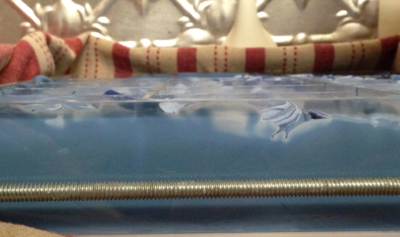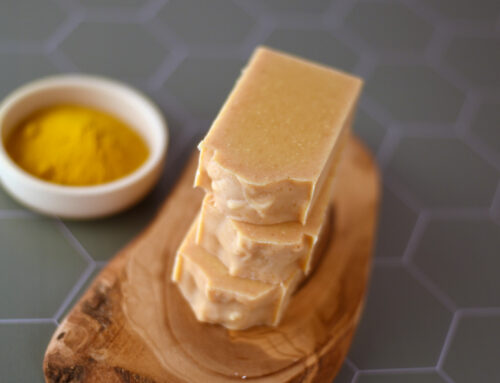Let’s talk about plant colorants that give us purple.
(Left to right: Alkanet (weak infusion), Alkanet (in Lye), Alkanet (20% of Olive oil), Alkanet (20% of total oils), Ratanjot (20% of Olive Oil), Ratanjot (20% of total oils), Gromwell (20% of Olive Oil), Gromwell (20% of total oils.)
Since writing my eBook on Natural Soap Color specifically using plant colorants (available exclusively at www.lovinsoap.com), I have had some questions from soapers that are wanting to try plant colorants.
One of the most common questions has centered around the use of Alkanet, Ratanjot and Gromwell to achieve purple colored cold process soap.
Alkanet, Ratanjot & Gromwell for Natural Purple
Firstly, Alkanet (Alkanna tinctoria), Ratanjot (Onosma Echioides) and Gromwell (Lithospermum Erythrorhizon) are, as you can see from their INCI names, different plant species. All three will give slightly different shades of purple.
Below is a photo of the three different colorants at the infusion stage and as you can see there is a slight difference in the colors.
Same strength infusions of A=Alkanet | R=Ratanjot | G=Gromwell
They do look similar and you would expect them to be as they all produce a shade of purple.
In my eBook I suggest using 1 oz. (30 grams approx) plant powder to 15 oz. (425 grams approx) of oil. I prefer to use a golden colored olive oil to ensure that the green color of some oil doesn’t mess with my purple color that I am trying to achieve. I now use light olive oil if I am trying to get purple or blue colors as that seems to give me the best result.
When I started I did use pomace olive oil, but consistently it was hard to find non-green pomace. You can use any oil you would like but, you will need to use an oil that is part of your recipe at the amount of 15% of the total oils or more. To be successful and achieve a purple color I have found for my recipe that I need to use 15% of my total oils in my batch as the infusion amount at least.
What happens if I don’t use 15%+ of the total oils in my batch?
The soap on the very left of the range of purples (top image) is what will happen. You will get a shade of grey. Occasionally grey is exactly what we would like to have, however when shooting for purple, grey is not what I want.
What happens if I choose to use less than 1 oz. of plant matter in my infusion?
Again, you will achieve a lovely shade of grey, just like the soap on the far left of the range of purple photo.
What if I choose to use green colored oils in my recipe?
You will have grey/green soap! Green and purple do not make a lovely shade of jewel/royal purple. No matter how much you wish it, you will get grey or even sometimes brown if your oil is really green!
Green or yellow (such as citrus) essential or fragrance oils will also mess with your purple, so try for clear oils if you can, or certainly a very light colored oils and only one green/yellow scent oil in a scent blend.
I don’t have time for a cold infusion what about if I put the Alkanet into the lye water?
I tried this myself and yes, that lovely brown soap in the purple range is you guessed it, Alkanet in the lye water (below).
2 tablespoons of Alkanet in the lye water.
I am forever lamenting that I can’t get a good brown, well, actually I can. I put Alkanet in the lye water and voila! Brown! It’s a good wood colored brown too, so I will remember this in the future when I want to do wood grained soap.
What if I made a mistake and I only used 15% of my olive oil amount rather than 15% of my total oil amount.
In the above photo the soap on the far right is 20% of my olive oil amount and the soap in the middle is 20% of my total oils. There is quite a difference in the color that you will get. This can be handy if you want a pink/lilac color at any stage but, pretty disappointing if you wanted purple.
The photo above also shows you the 3 different colors that I achieved with Alkanet. On the left Alkanet in lye (2 tablespoons added when the lye was hot and strained before adding to oils), 20% of total oils (middle) and 20% of the olive oil amount (right).
What the heck happened here? I wanted purple and I got blue from Alkanet!
Well in all honesty you should consider yourself very lucky. In all my time of soaping purple colorants I have achieved this phenomenon only recently. Of course I was not expecting it; however I will take it when given. I did everything the same as I normally do; 20% of the total oils was made up of my Alkanet infusion and low and behold it went blue in the mold after I poured it.
Not only did it go blue in the mold but, it stayed blue when I unmolded it 12 hours later. To say I was surprised would be an understatement; I had expected it to change to purple.
At the time I was trying out ideas I had for bright plant colorants so it was pretty convenient that it happened.
I took these photos as proof that yes it was indeed blue, because well who knows if that will happen ever again! The magic of plants… just when you think you have it exactly right, something pops up to prove you wrong.
Alkanet – blue rather than purple!
Alkanet – blue rather than purple!
The in-between blue and purple stage of Alkanet.
About 7 days after unmolding my blue soap had indeed turned to purple as the pH in the soap bar decreased.
Left to right Paprika, Annatto, Yellowdock, Alkanet.
The photo above shows the same Alkanet bar 8 days after unmolding and as you can see it is purple. I did wish it would stay the blue color I must admit.
What about fading? Everyone says that plant colorants fade!
Yes they do eventually fade. They are like flowers that you would cut and bring into your home; they will lose their color. I wish it was not so.
You might be surprised at how slowly they do fade though.
Ratanjot 2013 (back), Ratanjot 2015 (front)
This photo (above) shows the fading process of Ratanjot in soap. The soap at the back was made in 2013; the soap at the front was made in 2015. Both were made with the exact same recipe and both were stored in the dark in cardboard boxes in the same room so that I could compare their fading over time.
Ratanjot is actually my favorite of the three purple producing plant colorants. I find I am able to more consistently get a jewel purple from Ratanjot, however it is much harder to find. I have only been able to find it as a powder and not as a dried root and I was able to purchase it from Cranberry Lane in the States.
I hope you have enjoyed my answers to some of the questions posed. I hope you will try one or more of these purple producing colorants and please tag me if you do so I can oo and ah with you at the shade you created. Join the Facebook Group that I help admin; Saponification Nation. Of course if you have questions I am happy to try and answer them if I can.
My name is Jo Haslauer, and I LOVE soaping with plant colorants. I infuse them in oil, throw them into the lye water and add them at trace for their color, their herbal properties, and to enhance essential oil scents. I’m author of Natural Soap Color, an eBook that walks you through the process of using natural colorants in cold process soap to get a rainbow of colors.



















Can you please clarify when you said 15% of the olive oil, what was the percentage of olive oil in total oil? I want to try both. Thank you
I just infused my hard oils with 1tsp of alkanet root powder as they were melting, strained them and got a nice red burgundy color. But when I mixed the lye with the oils, my soap turned a bright blue/green !! Why did this happen? And will it magically change to purple as it cures? I was trying to make a lavender soap
This is not a duplicate comment: I read that I should add 1 TBLS Alkanet per 9 oz of oil for CP soap – so, I made 5 lbs of Elderberry Soap and added 5 TBLS – it turned out black. Will it still be usable? Also what would the correct amount be for a purple color?
I read that I should add 1 TBLS Alkanet per 9 oz of oil for CP soap – so, I made 5 lbs of Elderberry Soap and added 5 TBLS – it turned out black. Will it still be usable? Also what would the correct amount be for a purple color?
I can’t seem to buy Jo’s ebook- it keeps saying page not found when I click on the link…
I bought Jo’s e-book and would like to ask her a question. How can I contact her?
thank you! love all this information and understand I need to be patient and expect the unexpected with plant colorants!
Thank you for this awesome post. Now I finally know why my alkanet infusion gives me a different color everyone I use it. Also, thank you for pointing out the difference between ratanjot and alkanet. Too now I was under the impression that they are same. You are awesome Jo ?
And a big thank you to Amanda for this post!!! Your posts help me a lot in my soaking experiments ?
Am a graphic designer with a soapy side ? Big fan of you both!!
Great article Jo, you know I think you’re AWESOME!
Kyme
http://www.bohemienne.life (this IS my URL) this page refuses to recognize it.
Jo, I’m a big fan of yours. Always believed that Ratanjot (Hindi) is alkanet in English…lol. I will definitely try these infusions. Thanks for spreading the awareness.
Thanks, Jo! Love your book! Before reading it, I did get a deep purple. Once. And a good deep blue. Once. And a great baby pink. Once. I’m consistently inconsistent. ?
Just wondering — are there any natural colorants that can be used in lotions or creams?
Thanks,
judy
Many can! I believe Jo is working on putting together info on coloring other bath and body products using natural infusions…etc. As long as you add oil to them, you can simply add an infused oil if it is skin safe. Here I did an alkanet tinted lip balm. https://lovinsoap.com/2015/07/day-10-of-30-recipes-in-30-days-alkanet-tinted-natural-lip-gloss/
Excellent Information Jo and thanks for posting!